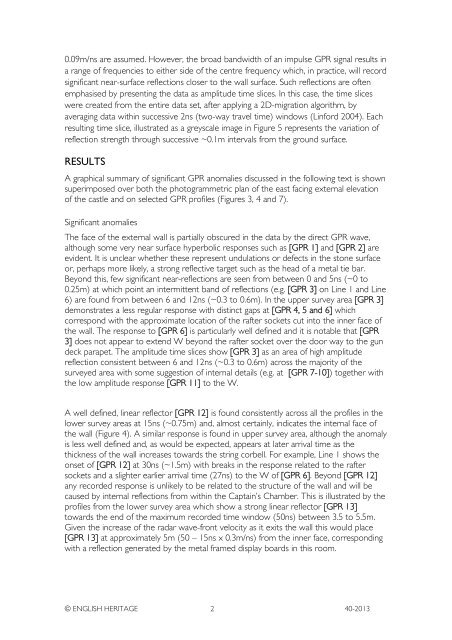Portland Castle, Dorset - English Heritage
Portland Castle, Dorset - English Heritage
Portland Castle, Dorset - English Heritage
You also want an ePaper? Increase the reach of your titles
YUMPU automatically turns print PDFs into web optimized ePapers that Google loves.
0.09m/ns are assumed. However, the broad bandwidth of an impulse GPR signal results in<br />
a range of frequencies to either side of the centre frequency which, in practice, will record<br />
significant near-surface reflections closer to the wall surface. Such reflections are often<br />
emphasised by presenting the data as amplitude time slices. In this case, the time slices<br />
were created from the entire data set, after applying a 2D-migration algorithm, by<br />
averaging data within successive 2ns (two-way travel time) windows (Linford 2004). Each<br />
resulting time slice, illustrated as a greyscale image in Figure 5 represents the variation of<br />
reflection strength through successive ~0.1m intervals from the ground surface.<br />
RESULTS<br />
A graphical summary of significant GPR anomalies discussed in the following text is shown<br />
superimposed over both the photogrammetric plan of the east facing external elevation<br />
of the castle and on selected GPR profiles (Figures 3, 4 and 7).<br />
Significant anomalies<br />
The face of the external wall is partially obscured in the data by the direct GPR wave,<br />
although some very near surface hyperbolic responses such as [GPR 1] and [GPR 2] are<br />
evident. It is unclear whether these represent undulations or defects in the stone surface<br />
or, perhaps more likely, a strong reflective target such as the head of a metal tie bar.<br />
Beyond this, few significant near-reflections are seen from between 0 and 5ns (~0 to<br />
0.25m) at which point an intermittent band of reflections (e.g. [GPR 3] on Line 1 and Line<br />
6) are found from between 6 and 12ns (~0.3 to 0.6m). In the upper survey area [GPR 3]<br />
demonstrates a less regular response with distinct gaps at [GPR 4, 5 and 6] which<br />
correspond with the approximate location of the rafter sockets cut into the inner face of<br />
the wall. The response to [GPR 6] is particularly well defined and it is notable that [GPR<br />
3] does not appear to extend W beyond the rafter socket over the door way to the gun<br />
deck parapet. The amplitude time slices show [GPR 3] as an area of high amplitude<br />
reflection consistent between 6 and 12ns (~0.3 to 0.6m) across the majority of the<br />
surveyed area with some suggestion of internal details (e.g. at [GPR 7-10]) together with<br />
the low amplitude response [GPR 11] to the W.<br />
A well defined, linear reflector [GPR 12] is found consistently across all the profiles in the<br />
lower survey areas at 15ns (~0.75m) and, almost certainly, indicates the internal face of<br />
the wall (Figure 4). A similar response is found in upper survey area, although the anomaly<br />
is less well defined and, as would be expected, appears at later arrival time as the<br />
thickness of the wall increases towards the string corbell. For example, Line 1 shows the<br />
onset of [GPR 12] at 30ns (~1.5m) with breaks in the response related to the rafter<br />
sockets and a slighter earlier arrival time (27ns) to the W of [GPR 6]. Beyond [GPR 12]<br />
any recorded response is unlikely to be related to the structure of the wall and will be<br />
caused by internal reflections from within the Captain’s Chamber. This is illustrated by the<br />
profiles from the lower survey area which show a strong linear reflector [GPR 13]<br />
towards the end of the maximum recorded time window (50ns) between 3.5 to 5.5m.<br />
Given the increase of the radar wave-front velocity as it exits the wall this would place<br />
[GPR 13] at approximately 5m (50 – 15ns x 0.3m/ns) from the inner face, corresponding<br />
with a reflection generated by the metal framed display boards in this room.<br />
© ENGLISH HERITAGE 2 40-2013

















